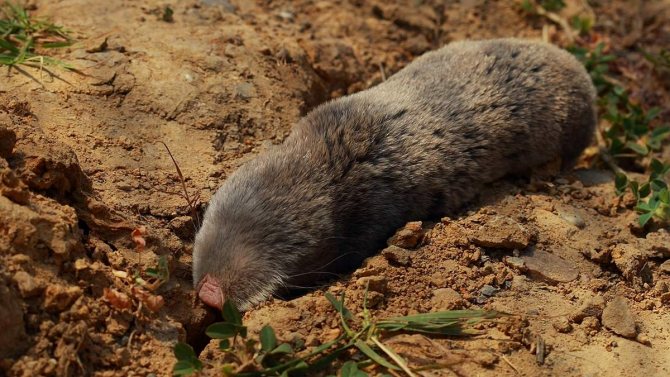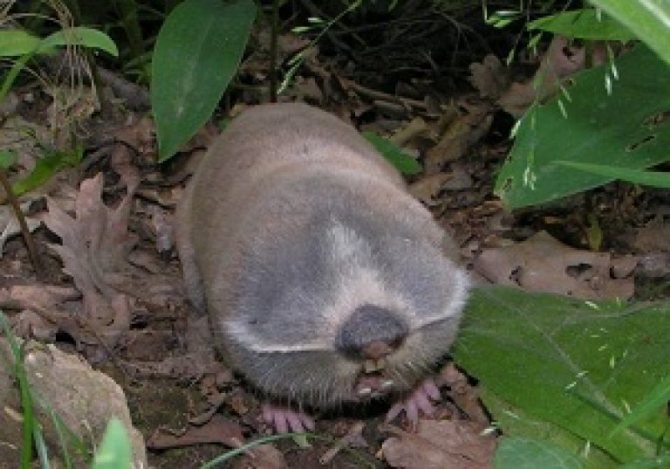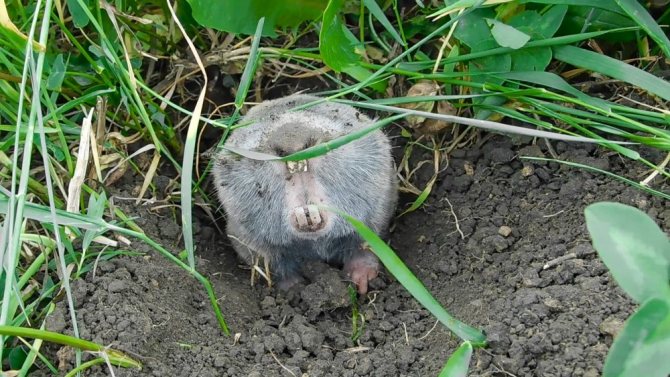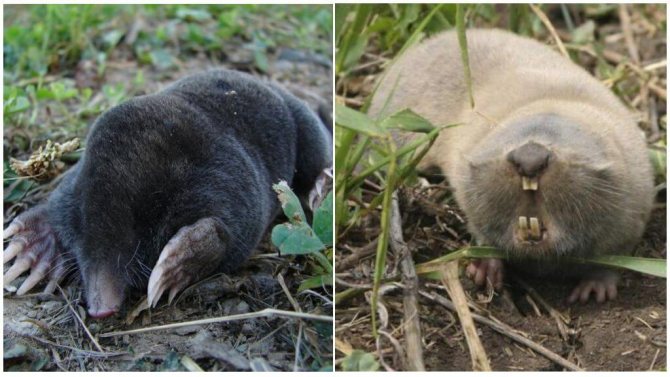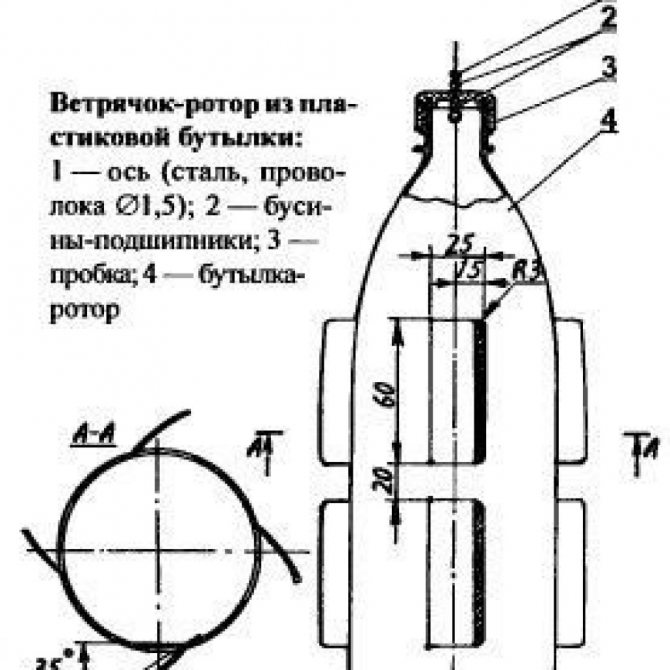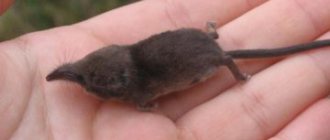EXCELLENT TOOL FOR MASTERS AND NEEDLEWORK AND EVERYTHING FOR THE GARDEN, HOME AND COTTAGE LITERALLY FREE + THERE ARE REVIEWS.

If heaps of land appeared at the summer cottage, while several bushes of vegetable plants disappeared, it's time to sound the alarm. There is no doubt that a mole rat has appeared on the site. In nature, there are several species of these rodents, which differ in color, size and place of residence. The common mole rat lives in our area. It belongs to the most common species.
Occupation and appearance
This animal does much more harm to the backyard than the well-known mole. If moles are only able to make underground passages and form mounds on the surface of the soil, then the common mole rat is able to gnaw many root crops, the harvest of which will not get to the owners - carrots, beets, potatoes. Even the mole mole rat loves to feed on foliage and stems of crops, bulbous flowers. For the winter, the animal mole rat makes food reserves, the volume of which in an adult can reach 10 kg.


It is not typical for this animal to hibernate, it simply becomes less active with the arrival of cold weather. Outwardly, this is an animal up to 30 - 32 cm long. The mole rat has a head slightly resembling a shovel in shape, reduced eyes - in their place there is a fold of skin. The ears and tail of the animal are rather weakly expressed, the body is densely covered with hair.
Distinguish between the common, Podolsk, Bukovinian, sandy, giant mole rat.
The giant mole rat is a rare species, the number of which sharply decreases every year.


The giant mole rat is listed in the Red Book of Russia. Its representatives give offspring 1 time in 2 years, while most of the young animals die in the first year of life. The giant mole rat disappears due to human activity on the ground - plowing, construction of irrigation canals, grazing. Under natural conditions, the giant mole rat is found only in semi-deserts located in the northeastern Ciscaucasia. Very rarely it can be seen along the rivers Terek, Sulak, Kuma.
The sand mole rat occupies an intermediate position in color between the common, Podolsk and Bukovinian on the one hand, and the giant one on the other. The sand mole rat is lighter in color.


The posterior part of the head, back and sides of the animal's body are yellowish-pale-gray in color. The sandy mole rat is a resident of the Lower Dnieper sands of the Kherson region. He likes to settle on slightly moistened soils belonging to the black earth type. The sand mole rat is most widespread where the wormwood, the Ukrainian goat, the bluehead, the cornflower and some other plants grow.
On our household plots, the most common naked species of mole rat is found.
Description
Mole rats are rats that are adapted to dig and live underground. They have short limbs, wedge-shaped skulls, strong neck muscles, large incisors, small eyes, and outer ears.
In zokors, who dig mainly with their feet rather than with their teeth, the front claws are significantly widened.
These features are least developed in bamboo rats, which spend part of their time above the ground foraging for food. Most pronounced in blind rats, whose eyes are completely covered with skin, and the outer ears and tails are completely absent.
All species of mole rats dig extensive burrows that contain chambers for storing food, latrines, and a nest. These are solitary animals, do not share territory with other individuals. All species are herbivores, feed on roots, bulbs, tubers.
Litters of up to six pups are born after a gestation period of three to seven weeks, depending on the species. Born blind, hairless, helpless. They stay with their mother for several months before setting off to create their burrows, although some species leave as soon as the female stops feeding.
What is different from a mole
The common mole rat, in contrast to the mole, is larger, and its limbs are five-toed, with small claws and less developed. The mole is rather created by powerful teeth, and the earth does not enter the rodent's mouth, since the lips with folds are behind the scars.
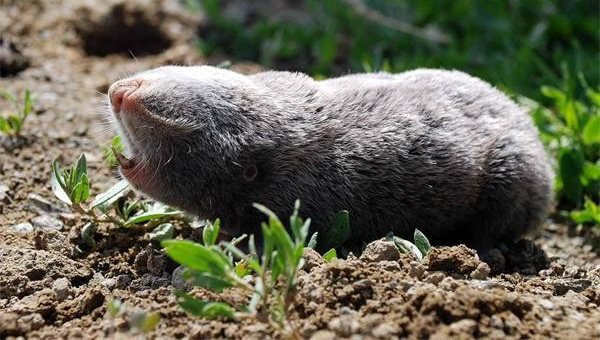

If moles prefer to eat insects, then these animals eat roots, tubers and bulbs. In order to get to the terrestrial part of the cultures, they carry them by the root to their home. Most of all, the animals like umbellate plants, asteraceae and legumes. Stems and leaves often become their prey in spring or early summer.
Harm


Mole rat holes
From the activity of this pest, long tunnels of several tiers remain in the garden, as well as underground storerooms, in which the animal stores part of the crop grown by the owners in their gardens. As a rule, he eats first of all the green mass, and adds up the roots for the winter. Even one mole rat is able to take away a considerable share of the crop. If several individuals appear on the site, then you can forget about high yields of crops such as potatoes, onions, beets and carrots.
In addition, he digs rather large passages, with a diameter of 5 to 15 cm, due to which he damages some plants on the site. The lower tiers can be at a depth of up to 3 meters, and the upper ones - at a depth of 10 cm. Such a system of underground passages often does not allow the normal development of many cultivated plants.
Where dwells
For his habitat, he most often chooses fields, steppes, forest belts, ravines, virgin lands.
The mole rat's underground passage systems have two tiers. The first is located at a depth of no more than 25 cm from the surface and is food, the second is at a depth of 3-4 meters. The second has nests for summer and winter, as well as food storage.
The mole digs the soil with its front paws, and the naked mole rat uses strong incisors. Heaps of earth are larger than those of moles. Hillocks can have a diameter of up to 50 cm, and the earth thrown to the surface sometimes has a mass not much less, but about 10 kg.
The blind dacha can do a lot of harm, and its destruction is very difficult to carry out, since the animal is underground for most of its life.
How does a mole rat breed?
Only one female breeds in the family group each year; if there are two females in the group, then in the spring the male leaves the area of the breeding female and forms a pair with the female that will breed next year. Cubs are born from late February to mid-May. There are 2-3 cubs in a brood. The main reproductive contribution is made by females aged 3-7 years. From the end of May, the dispersal of young animals from broods begins, partly on the surface, partly underground, dispersal continues until autumn. Young males predominantly settle in the second year of life and mainly underground, females - in the first year and often on the surface, which leads to a greater mortality of females in the first year of life. The dispersal range varies from several tens to several hundred meters.


Methods, tools and traps for the fight
The most popular way of fighting, when a mole rat is found on the site, is the use of strong poisons. They are similar to the poison that can poison rats.In view of the high toxicity of such drugs, it is recommended to set a trap or live trap in the garden. But thanks to natural ingenuity, rodents are able to bypass the installation site of such traps. Even in case of danger, a small mole rat can show aggression - growl and expose powerful teeth. A livestock trap or trap should be set when leaving the mink. There is also a known method of catching animals with a hook.
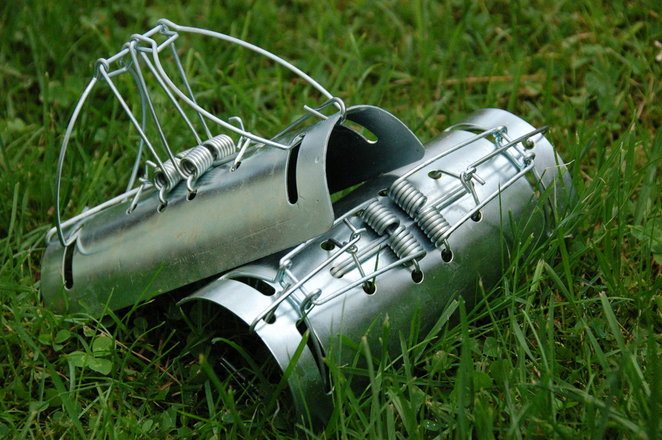

It is necessary to dig out the norm and insert a long wire with a hook or several at once.
A loop is made at the other end of the wire. It is needed to secure the hook in the hole. If there is a draft, the animal rushes to the exit and gets hooked. Then the owner decides how to get rid of the mole rat. The use of crossbows, traps and poisons is considered inhumane, so animal lovers prefer to get rid of pests with water and an electronic repeller. Another method is to smoke rodents out of the home by attaching a hose to the car's exhaust pipe. But it is so real along the way to pollute the land on the site. The electronic repeller has a good effect, since the animals cannot tolerate vibration and tend to leave the garden.
HOW TO FIGHT BLIND
Specific measures to combat this pest have not yet been proposed. The recommended methods are controversial, which indicates that the biology of the animal is poorly understood. It is difficult to take it out of the garden, because the rodent hardly appears on the surface, and thanks to its well-developed instinct, it can avoid the installed traps.
Nevertheless, there is one rather effective way to get rid of such a neighborhood. To do this, you need to take a rag, moisten it in gasoline, kerosene and other foul-smelling substances and bury a few rags in the ground at different depths. In addition to hydrocarbons, animals react negatively to essential oils of plants such as eucalyptus, cedar, lavender.
You can try using special cartridges designed to fight the mole. To do this, you need to dig out the course, set fire to the "ammunition" and insert it into the course. Acrid smoke will begin to stand out, which disperses along the paths, not rising up.
In the process of fighting this voracious animal, it was also found that it is afraid of noise. If loud sounds are constantly present on the site, then the pest will try to leave the territory. To implement this method, metal rods up to 1 m long will be required. For example, a piece of reinforcement is hammered into the ground so that 40 cm remains above the surface. An empty metal can is put on the upper end and wait for windy weather. From the gusts, the bank will begin to hit the support, and an unpleasant noise will spread underground.


ELECTRONIC BLIND CONTROL
Thanks to the rapid development of electronics, it was possible to create modern devices that emit ultrasonic waves of various frequencies. A person does not perceive them, but many animals react negatively to ultrasound. Sound waves in this range cause a feeling of fear in rodents, as a result of which they start to panic, and they try to leave the uncomfortable area as soon as possible. Very little time passes, and the animals leave from there in search of more favorable conditions.
For an effective fight, it is necessary to install several such devices. In this case, it makes no sense to additionally set any traps. Ultrasonic "scarecrows" will operate throughout the entire site. They will help get rid of pests even if a good harvest is ripening in the garden, which rodents can covet. Such devices will help the owner get rid of not only mole rats, but also other pests. Moles, shrews, bears, and other unwanted "guests" cannot stand ultrasound.The main thing is to choose the right devices in terms of power so that they can protect the entire site.
Encouraging cats to hunt
How to get rid of harmful animals with the help of animals? You must first find the places under which the underground communications of animals are located. Next, they dig out about half a meter of the tunnel with a shovel. As mentioned above, the naked mole rat reacts sharply to a draft. Therefore, having made a hole, it is necessary to expect the appearance of a naked animal together with the cat. It will be especially easy for your pet to catch a young and inexperienced pest. You can also attract a dog with the necessary skills to catch animals on the site.
Traps
Our grandparents, in order to get rid of this rodent, placed various traps or traps throughout the garden. They can either be bought in specialized stores or made with your own hands. The most important thing in this matter is the correct installation of the trap so that it works exactly. The matter is complicated by the fact that this rodent rarely comes out and does not live in every burrow. Therefore, the most inhabited burrow should be considered the one next to which there is a pile of freshly dug earth. Ideally, each burrow should have one trap.
The rodent does not like a draft very much, if it begins to feel it in its home, then it tries to quickly find a hole and plug it up. Therefore, before setting the trap, they first find a hole with a fresh pile of earth nearby. Then they break the soil until they come across a blockage. Then it is carefully removed and a trap or trap is placed next to it. In half an hour or an hour, the animal will fall into it. More experienced animals can easily bypass this obstacle. If this method did not work, then you can move on to the next one.
Using water for fishing
Another way not destroying, but helping to catch a rodent is the use of water. You will need a watering hose and about 10 liters of liquid. After finding a tunnel that leads to the animal's dwelling, you should dig a hole near the embankment with clay and send water there. In order for the animals to be on the surface, it is necessary to generously fill the underground passages due to their helical shape. Using such a tool, each owner of the garden will be able to catch uninvited guests from the site. How to get rid of them further, you will have to decide for yourself.
Poisons for the mole rat
Method - the use of various poisons. This is a fairly effective method, but if there is a good food base for the mole rat on the bed, then he may not touch the poison. There are gardeners who put various waste into their holes, watered them with essential oils and kerosene. But even that didn't always help.
If the gardener has an electric pump and there is a pond or reservoir nearby, then you can try to fill the holes with water. However, if the soil absorbs water well (for example, sandy), then it will not work to flood the mole rat.

